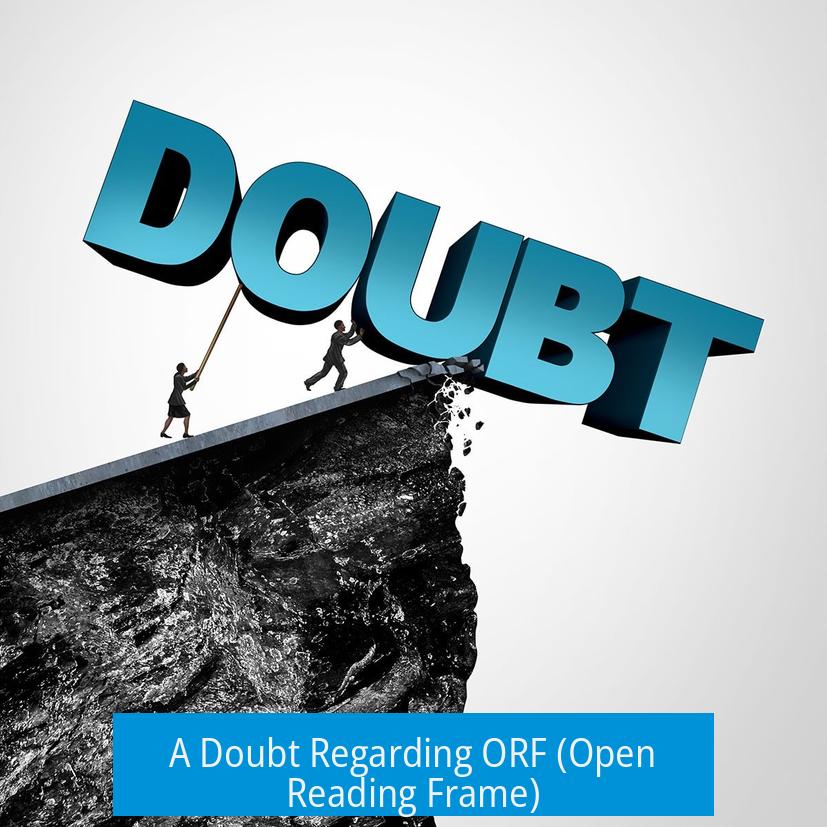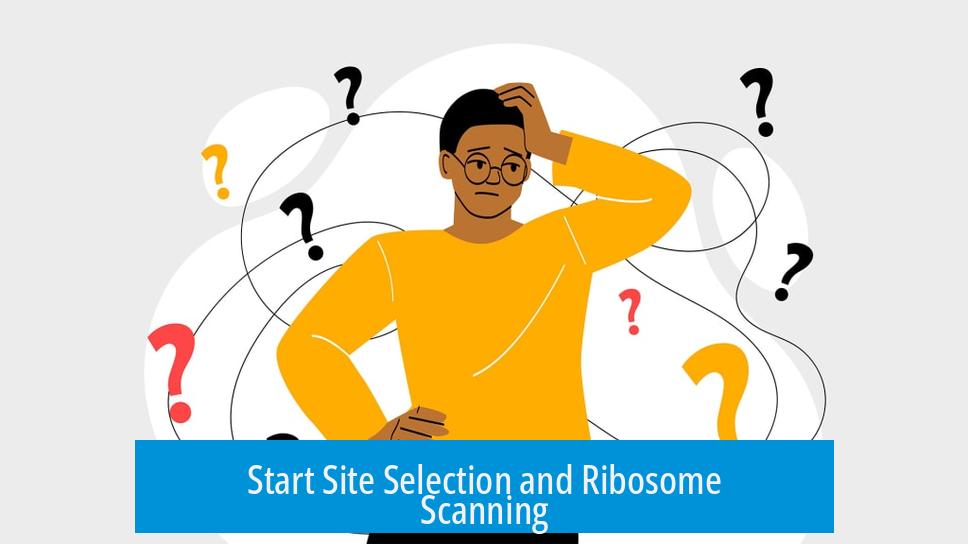A Doubt Regarding ORF (Open Reading Frame)

An open reading frame (ORF) begins at the first suitable start codon (usually the first ATG after the ribosome binding site) on an mRNA and continues until a stop codon is encountered. The identification of the ORF is critical to understanding which portion of an mRNA codes for a protein.
Understanding ORF in Genomic Context
The ORF represents the DNA or RNA segment likely to be translated into protein. According to reference genomic resources, ribosomes scan mRNA from the 5’ end and assemble at the optimal start site, which is the first ATG occurring downstream of the ribosome binding site. This site is usually just a few nucleotides away from the ribosome binding sequence.
Multiple ATG codons can appear in an mRNA sequence, but the ribosome generally initiates translation only at the first valid start codon. Subsequent ATGs often do not serve as start sites because ribosomes commence protein synthesis at the earliest recognized translation initiation site.
Start Site Selection and Ribosome Scanning

- Ribosomes scan mRNA looking for a suitable start codon embedded within the correct context.
- The process involves confirmation that the mRNA is properly processed—spliced, capped, and intact.
- Ribosomes engage with proteins that help select the best initiation codon for translation.
Frameshifts and Their Impact on Translation
If translation starts out of frame due to a frameshift mutation, the ribosome encounters stop codons prematurely. Such frameshifts often result in nonsense sequences causing the translation to terminate early. For example, CRISPR/Cas9 gene knockouts frequently operate by inducing frameshifts that introduce premature stop codons, halting protein production.
Experimental approaches can confirm the effects of frameshifts by deliberately shifting the reading frame of known genes to observe the rapid termination of translation.
Summary of Key Points

- The ORF begins at the first ATG after the ribosome binding site on mRNA.
- Ribosomes scan mRNA to locate an appropriate start codon before translation.
- Additional ATGs downstream rarely serve as start codons once translation initiates.
- Frameshift mutations introduce premature stop codons, disrupting translation.
- Translation initiation is tightly regulated through interactions between ribosomes and accessory proteins.
Clearing Up a Doubt Regarding ORF: A Simple Dive Into the Mystery
What exactly is an ORF, and how do you spot one in a new mRNA sequence? Here’s the straightforward answer: the first ATG codon after the ribosome binding site typically marks the start of an Open Reading Frame (ORF), which is essentially the “protein blueprint” on your mRNA. Other ATGs down the line usually don’t get a chance to shine because the ribosome has already started its job.
Now that we’ve dropped the key fact, let’s unpack it with some clarity and a dash of humor — because genetics is fascinating, but it doesn’t have to be dry.
What’s an ORF Anyway?

ORF stands for Open Reading Frame. It’s a stretch of nucleotides in messenger RNA (mRNA) that can be translated into a protein. Think of it like a string of letters in a secret code. The ribosome is the decoder, and it reads this string three letters at a time (codons) to assemble amino acids into proteins. But just like any decent story, you need a clear beginning, middle, and end.
Finding the Start: Where Does Translation Begin?
Imagine you’ve unearthed a brand new mRNA sequence. The big question: where does the ribosome start reading? Here’s the detective work:
- Look near the front of the mRNA for the Ribosome Binding Site (RBS). This site is like a VIP pass, attracting the ribosome to the mRNA. Without this pass, no translation party begins.
- Just a few nucleotides downstream of the RBS, you will usually find the first ATG codon. This codon signals, “Start here!” It codes for methionine, the first amino acid in the nascent protein.
Interestingly, the other ATGs found later? They’re like understudies who never get their cue because the ribosome has already started producing protein from the first ATG.
Why Can’t Ribosomes Start at Later ATGs?

The ribosome doesn’t jump around willy-nilly. It establishes a set reading frame from that first ATG. If it starts reading the “sentence” mid-way, the protein would be gibberish. A neat trick, right? The ribosome’s loyalty to the first ATG ensures proteins are made correctly and consistently.
Frameshifts: When Things Go Wrong
But what if the reading frame is shifted? Enter the big villain—frameshift mutations.
A frameshift shifts the “reading frame,” changing how every codon downstream is read. Usually, this causes a nonsense parade: unexpected stop codons emerge, cutting the protein short. This is why CRISPR/Cas9 knockouts often cause gene disruptions — they often introduce frameshifts, leading to premature stop signals that end translation abruptly.
Think about it like having a sentence where one letter is deleted or added, changing “The cat sat” to “Hec ats at.” Suddenly, the message is garbled and nonsensical.
Want Proof? Try This Ribosome Experiment
Curious about frameshifts? Try flipping the translation frame on your favorite gene experimentally. You’ll likely see how quickly the “protein party” crashes with early stop codons popping up repeatedly.
This practical approach boosts understanding. Plus, seeing the ribosome fail to produce a functional protein firstly highlights its precision.
How Do Ribosomes Decide the Best Start Site?
Ribosomes don’t just stumble upon the first ATG blindly. They do a kind of quality check called “ribosome scanning.”
- The ribosome moves along the mRNA, assessing if it’s fit for translation. Is it properly capped? Spliced? Does it have legitimate start and stop codons? If the answer’s no, the mRNA faces degradation — destruction! Harsh but necessary.
- When the ribosome finds a promising mRNA, it binds at the best start codon. This choice involves contacts with various auxiliary proteins, fine-tuning the start point.
Because there are 64 codons and only 20 amino acids, and since one codon codes methionine, multiple ATGs can appear. Yet, the ribosome’s scanning and regulatory mechanisms ensure that the translation begins in the right frame.
Why Does This Matter?
Understanding where translation starts is crucial for genetic engineering, biotechnology, and research.
- Designing synthetic genes or mRNAs requires knowing how ribosomes recognize start codons.
- Gene editing techniques like CRISPR rely on inducing frameshifts to knockout genes. Understanding frameshifts’ consequences helps improve these tools.
- Studying frameshift mutations aids disease research because many genetic disorders arise from such mutations.
What About the Reference Graph on ORFs?
There’s a valuable resource to deepen your understanding: the ORF section on the LibreTexts Genomics page (check it out here).
This section includes graphs showing how ORFs appear in a given DNA or mRNA sequence. You can visually analyze where ORFs start and stop, highlighting the impact of frameshifts and stop codons. It’s a neat tool for visual learners who want the nitty-gritty details.
Final Takeaways: Decode Your Doubts
In summary, that nagging doubt about ORFs boils down to: the first ATG after the ribosome binding site is your star player. The ribosome’s scanning mechanism is a precise system that picks this start codon and sticks with it. Frameshifts lead to early stop codons, usually halting translation.
Next time you encounter a new mRNA, picture the ribosome as a careful reader scanning for a starting point. Keep frameshifts in mind—they’re the sneaky plot twists that usually ruin the story.
Feeling more confident now? Still puzzled? Share what you understood or where it gets murky. Sometimes, discussing these genetic mysteries with fellow enthusiasts sparks that “aha!” moment.
What determines the true start site of translation in a new mRNA sequence?
Ribosomes scan near the front of the mRNA for a ribosome binding site. The first ATG codon just after this site usually acts as the real start. Later ATGs are ignored since translation starts at the first one.
Why don’t downstream ATGs usually serve as translation start sites?
Once the ribosome begins translation at the first ATG, it doesn’t restart at later ATGs. The ribosome traffic prevents any secondary start codons from being used, so they generally have no effect.
What happens if a frameshift mutation occurs in an open reading frame (ORF)?
Frameshift changes the reading frame and introduces stop codons prematurely. This leads to early termination of protein synthesis, causing truncated or nonfunctional proteins.
How can the effects of frameshifts in gene translation be experimentally tested?
You can induce a frameshift mutation in a gene and observe how quickly translation terminates. This reveals how often rogue stop codons appear and how frameshifts affect protein synthesis.
How does the ribosome select the best start codon on an mRNA?
The ribosome scans the mRNA and assembles at the most suitable start site based on signals and protein contacts. This regulated process ensures correct initiation amid many potential methionine codons.





Leave a Comment